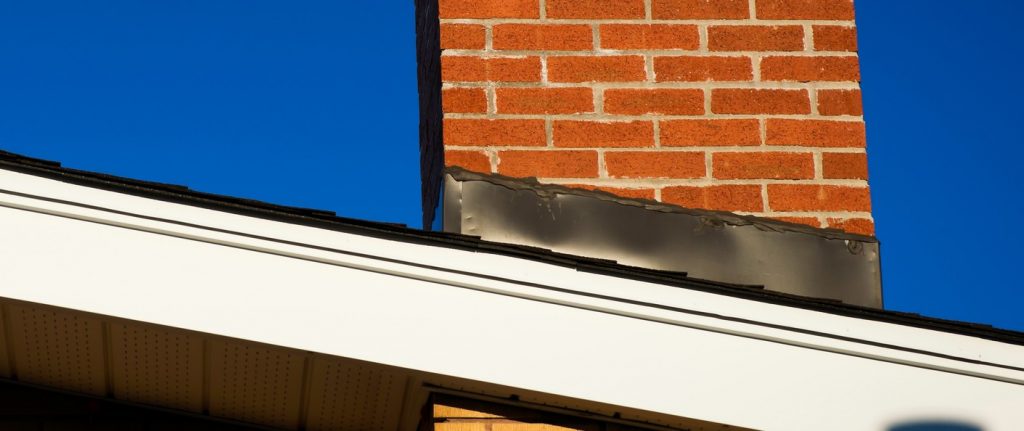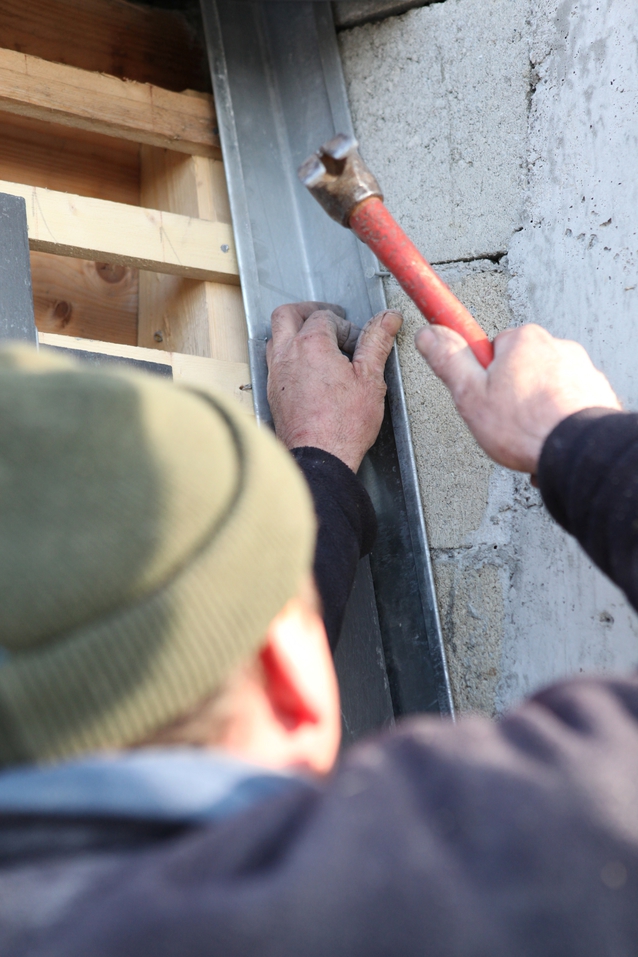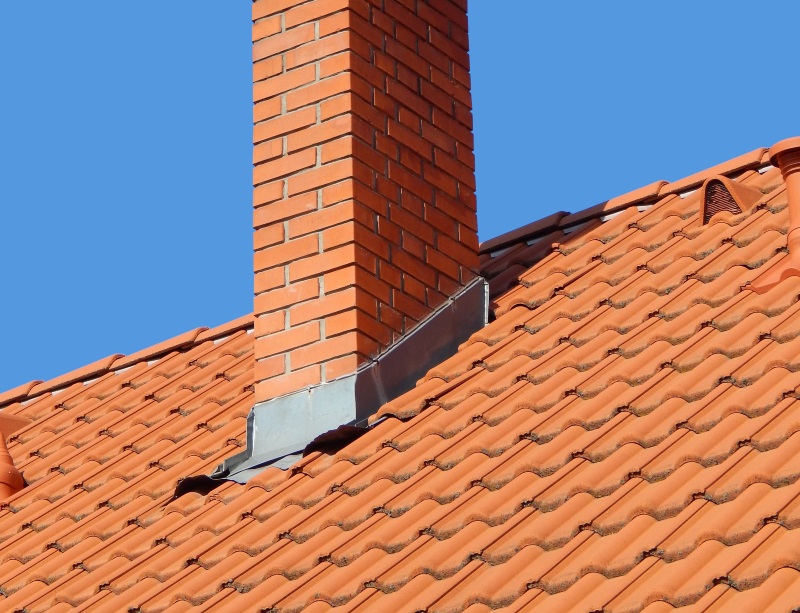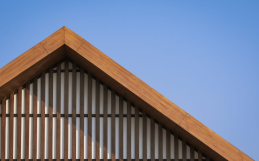(Updated August 2025)
Why roof flashing is important for your home
 Most homeowners never think about roof flashing—until a leak shows up in the attic, around the chimney, or near a skylight. Flashing may look like thin strips of metal tucked along joints and seams, but it’s one of the most important parts of your roofing system. Without properly installed flashing, even the best shingles can’t keep out water.
Most homeowners never think about roof flashing—until a leak shows up in the attic, around the chimney, or near a skylight. Flashing may look like thin strips of metal tucked along joints and seams, but it’s one of the most important parts of your roofing system. Without properly installed flashing, even the best shingles can’t keep out water.
This guide explains what roof flashing is, the types of roof flashing you’ll see on a home, the materials professional roofers use, and why damaged or missing flashing is one of the leading causes of roof leaks.
What is roof flashing and what does it do?
Roof flashing is a protective barrier that directs water away from vulnerable areas where two different roofing materials or surfaces meet. Think of it as the “gutter system” for the most leak-prone joints on your roof.
Flashing is typically made from galvanized steel, aluminum flashing, or copper. These rust-resistant materials are bent into shape and installed around chimneys, skylights, dormers, roof valleys, and along eaves. The goal is simple: to keep water from finding a path into your home.
Why does every roof need flashing to prevent leaks?
Your roof surface is designed to shed water downward. But wherever two slopes connect, or a vertical surface intersects the roof (like a wall, chimney, or vent pipe), water naturally slows down and pools. Without flashing, these areas are exposed to constant runoff, which can seep into joints and cause:
- Persistent roof leaks
- Mold and moisture damage inside walls
- Rotted fascia boards or siding
- Structural damage to framing over time
Proper flashing, when combined with quality shingles and underlayment, gives your roofing system the layered protection it needs to stand up to decades of rain, snow, and wind.
What materials are used for roof flashing?
 Professional roofers choose flashing materials based on budget, durability, and how easy they are to work with. Common roofing materials for flashing include:
Professional roofers choose flashing materials based on budget, durability, and how easy they are to work with. Common roofing materials for flashing include:
- Galvanized steel: The most widely used material thanks to its strength, affordability, and resistance to corrosion.
- Aluminum flashing: Lightweight and easy to bend—popular for DIY but not as durable as galvanized or copper.
- Copper: Expensive but extremely durable, often used on high-end homes or custom copper roofs.
- Lead or rubber boots: Sometimes used for sealing vent pipes.
- Pre-painted sheet metal: Helps match the roof surface and improves corrosion resistance.
What are the main types of roof flashing?
Step flashing
Used where a roof meets a vertical wall or dormer. Small overlapping pieces of flashing are installed like shingles, “stepping” up the wall. Step flashing ensures water running down the roof is directed away from the wall and onto the shingles below.
Counter flashing
Commonly used with chimneys or masonry. Counter flashing is installed into the mortar joints of a brick or stone surface and overlaps the base flashing to create a watertight seal.
Base flashing and chimney flashing
Around chimneys, multiple flashings work together:
- Base flashing runs at the bottom.
- Step flashing climbs the sides.
- Counter flashing locks into masonry.
- A saddle or cricket may be built on the uphill side to divert heavy runoff.
This layered system prevents water from penetrating one of the most leak-prone spots on any roof.
Apron flashing
Also known as continuous flashing, this is a long strip of metal used where a roof surface meets a vertical wall, such as the base of a dormer. Apron flashing helps water run smoothly down the shingles without entering the seam.
Drip edge flashing
Thin strips of flashing installed along the eaves and rakes of the roof. Drip edges keep water from seeping under the shingles and direct it into the gutters instead of behind fascia boards.
Valley flashing
Open metal flashing installed in roof valleys where two slopes meet. This ensures runoff flows quickly into the gutters instead of under shingles.
Vent pipe flashing
Rubber or metal boots that seal around plumbing or HVAC penetrations. Without vent pipe flashing, even small gaps around pipes can become major leak sources.
How can you tell if your roof flashing is damaged?
Because flashing protects your roof’s most vulnerable points, even small failures can lead to water damage. Warning signs include:
- Roof leaks near chimneys, skylights, or dormers
- Missing pieces of flashing after a storm
- Rust, corrosion, or small holes in metal flashing
- Bends, cracks, or warping from wind or hail
- Mold or staining on fascia boards from faulty drip edges
- Water-stained ceilings or attic leaks
- Damaged siding or shingles near flashing points
What causes roof flashing to fail over time?
 Even though flashing is metal, it’s not indestructible. Damage often comes from:
Even though flashing is metal, it’s not indestructible. Damage often comes from:
- Poor installation or improper repairs
- Weather extremes (ice, hail, wind, heavy rain, heat)
- Corrosion over time, especially in coastal areas
- Wildlife damage (birds, raccoons, etc.)
- Normal wear and tear as roofing ages
This is why professional roofers stress that flashing should be inspected whenever you schedule roof repairs or maintenance.
How do professional roofers install roof flashing?
To install roof flashing correctly, roofers cut and bend the metal to fit snugly around the feature it’s protecting (chimney, skylight, dormer, etc.). Flashing is layered with shingles, sealed with roofing cement where appropriate, and secured to shed water in the right direction.
A properly installed flashing system is integrated with underlayment and shingles—not just nailed on top. Done right, it becomes nearly invisible but absolutely essential to your roof’s long-term performance.
Can roof flashing be repaired, or does it need replacement?
If you notice a leak, don’t assume the shingles are to blame. In many cases, flashing—not the shingles—is the culprit. Replacing or repairing flashing can often solve leaks without requiring a full roof replacement.
However, because flashing ties into shingles, underlayment, and sometimes siding or masonry, flashing repairs are best left to professional roofers. They know how to reseal joints, match new materials to old, and maintain the integrity of the entire roofing system.
Should you repair flashing yourself or hire a professional roofer?
You might see tutorials about DIY flashing repair, but it’s a risky project. Working on a roof is dangerous, and incorrect repairs can make leaks worse. Professional roofers have the training to:
- Identify hidden flashing failures
- Work safely at heights
- Choose the right types of roof flashing for your roof
- Integrate flashing seamlessly into your existing roof surface
The safest and most cost-effective choice is to call a pro—especially when you notice water stains, leaks, or missing flashing.
How can you prevent roof flashing problems in the future?
You can extend the life of your flashing with regular roof maintenance:
- Inspect your roof in spring and fall.
- Clear gutters to reduce water backup.
- Look for rust, missing pieces of flashing, or lifted shingles.
- Schedule inspections after major storms.
Catching problems early makes roof repairs simpler and protects your investment in your home.
FAQs: Homeowner questions about roof flashing
- What is roof flashing made of?
Most flashing is made from galvanized steel, aluminum flashing, or copper. Each offers different levels of durability, corrosion resistance, and cost. - Where is roof flashing installed?
Flashing is placed wherever two surfaces meet or water runoff is heavy—chimneys, dormers, roof valleys, vent pipes, skylights, and eaves with drip edges. - How do I know if my flashing is failing?
Look for leaks inside, rust or holes on flashing, or damaged siding and fascia. Missing or bent flashing after storms is also a warning sign. - Can roof flashing be repaired, or does it need replacement?
Minor damage may be patched with sealant, but rusted, bent, or missing flashing usually needs replacement. Professional roofers can tell which option is best. - How long does flashing last?
When properly installed, flashing can last as long as your shingles—20 years or more. Copper and high-quality galvanized steel may last even longer.
Protect your home with expert roof flashing installation and repair
Flashing may be just thin strips of metal, but it plays a huge role in keeping your home safe, dry, and energy efficient. If you’ve noticed leaks, stains, or missing flashing—or if it’s simply time for a roof inspection—Warner Roofing & Construction is here to help.
Our team of experienced professional roofers knows how to install and repair flashing so your roofing system works exactly as it should. We’ll explain your options, handle repairs with craftsmanship, and make sure your roof can stand the test of time.
Contact Warner Roofing & Construction today for a free estimate or to schedule a roof inspection.







